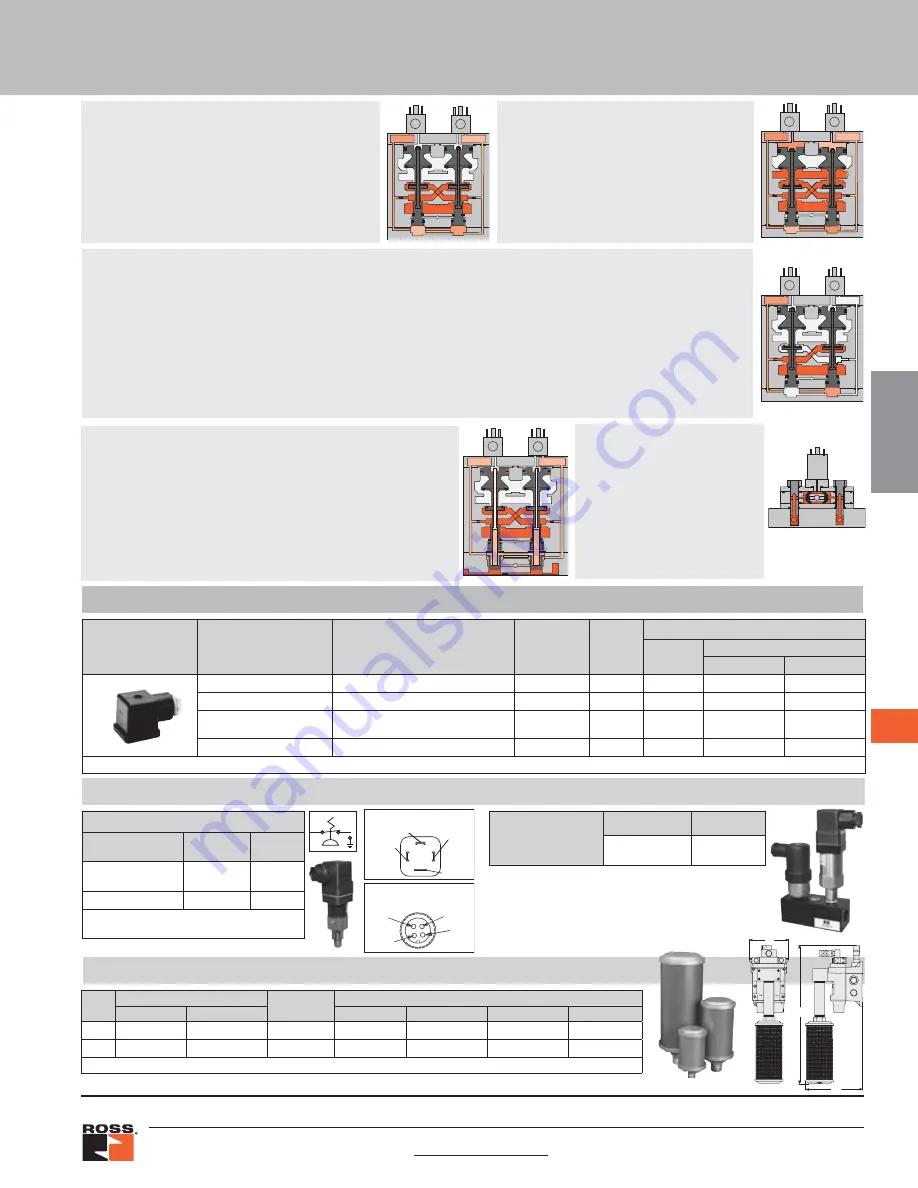
IMPORTANT NOTE:
Please read carefully and thoroughly all of the
CAUTIONS, WARNINGS
on the inside back cover.
F3.7
www.rosscontrols.com
Online Version
Rev. 11/14/16
Status Indicator:
The status indicator pressure switch
will actuate when the main valve is
operating normally, and will de-ac-
tuate when the main valve operation
is sufficiently asynchronous or inlet
pressure is removed. This device is
not part of the valve lockout function,
but, rather, only reports the status
of the main valve.
Asynchronous Operation:
If the valve elements operate in a sufficiently asynchronous manner on ACTUATION, the valve
will shift into a position where one crossover and its related timing chambers will be exhausted, and the other crossover and its
related timing chambers will be pressurized.
In the illustration, side B is in the de-actuated position, but has no pilot air available to actuate with and has full pressure on its
upper and lower inlet poppets and return piston to hold it in place.
Inlet air flow on side B into its crossover is restricted and flows through the open upper inlet poppet on side A, through the outlet
into the exhaust port, and from the exhaust port to atmosphere. Residual pressure in the outlet is less than 1% of inlet pressure.
Once the main solenoids are de-energized, actuating pressure is removed from the top of the main pistons and then the lower
inlet poppet return spring along with inlet air pressure acting on the side A return piston will push side A back into the de-actuated
position. Inlet air pressurizes the crossovers and volume chambers. Pressure in the crossovers helps hold the upper inlet poppets
on seat. The valve will then be in the ready-to-run position. On the next attempt to actuate normally, if side B is still unable to
actuate synchronously with side A, the same sequence of events described above will occur again.
Valve actuated:
Energizing the pilot solenoids
simultaneously applies pressure to both pistons,
forcing the internal parts to move to their actuated
position, where inlet air flow to outlet is open and
both exhaust poppets are closed. The outlet is
then quickly pressurized, and pressure in the
inlet, crossovers, outlet, and timing chambers
are quickly equalized. De-energizing the main
solenoids causes the valve elements to return
to the ready-to-run (de-actuated) position.
Valve de-actuated (ready-to-run):
The flow of inlet
air pressure into the crossover passages from the inlet
chamber is restricted by orifices that allow air pressure to
bypass the lower inlet poppets. Flow is sufficient to quickly
pressurize the pilot supply/timing chambers on both sides
A and B. The upper inlet poppets prevent air flow from the
crossover passages into the outlet chamber. Air pressure
acting on the inlet poppets and return pistons securely hold
the valve elements in the de-actuated position. (Internal air
passages shown out of the valve body for clarity.)
Status indicator
in normal
ready-to-run
position
WARNING:
If asynchronous operation occurs while DE-ACTUATING,
the pilot supply/timing chambers on one side will still be exhausted as
described above. However, this could be a temporary situation because
the cause of the asynchronous operation may be able to correct itself
allowing the stuck or slow acting side of the valve to eventually move
back into the de-actuated position. Once the slow or stuck side has
de-actuated, the pilot supply/timing chambers that were exhausted will
then repressurize. If an external monitoring system is only checking
the status indicator periodically this fault signal could be missed. The
machine’s safety system must be designed to ensure that this does
not cause a hazardous situation.
EXHAUST
T
T
T
T
T
INLET
OUTLET
EXHAUST
OUTLET
INLET
A
B
EXHAUST
T
T
T
T
T
INLET
OUTLET
EXHAUST
OUTLET
INLET
A
B
EXHAUST
OUTLET
INLET
A
B
EXHAUST
T
T
T
T
T
INLET
OUTLET
EXHAUST
OUTLET
INLET
A
B
o
ptions
High-Flow, High Reduction Silencer Kits
A
B
C
Basic
Size
Kit Number
*
Flow
scfm
Dimensions
inches (mm)
NPT threads BSPP threads
A
B
(NPT)
B
(BSPP)
C
2, 4
2324H77
2329H77
800 (378) 4.34 (110.2) 19.06 (484.1) 21.40 (543.6) 7.27 (184.7)
8
2325H77
2330H77
800 (378) 5.41 (137.4) 21.18 (538.0) 23.52 (597.4) 8.41 (213.6)
*
Kits include all plumbing required for installation.
Pressure Range:
125 psig (8.6 bar) maximum.
Designed to improve equipment performance and reduce the Exponentially Perceived Noise (EPNdB) in the 35–40 dB range.
F
F3
Control Reliable Double Valves
with Dynamic Monitoring
DM
1
Series C
Valve Operation & Options
•
May be installed downstream on all double valves
•
Provides a redundant means to verify the release of
downstream pressure to next obstruction
•
Factory preset, 5 psi (0.3 bar) - falling
Downstream Pressure Monitoring
Redundant
Downstream
Feedback Switch
Model Number Port Threads
RC26-13
3/8 NPT
Electrical
Connectors
Electrical
Connector
Form
Electrical Connector Type
Cord Length
meters (feet)
Cord
Diameter
Electrical Connector Model Number
Without
Light
Lighted Connector
24 Volts DC
120 Volts AC
EN 175301-803 Form A Prewired Connector (18 gauge)
2 (6
1/2
)
6-mm
721K77
720K77-W
720K77-Z
EN 175301-803 Form A Prewired Connector (18 gauge)
2 (6
1/2
)
10-mm
371K77
383K77-W
383K77-Z
EN 175301-803 Form A
Connector for threaded conduit
(1/2 inch electrical conduit fittings)
–
–
723K77
724K77-W
724K77-Z
EN 175301-803 Form A Connector Only
–
–
937K87
936K87-W
936K87-Z
CAUTIONS: Do not use electrical connectors with surge suppressors, as this may increase valve response time when de-actuating the solenoids.
Pressure Switches
Connection Type
Model
Number
Port
Threads
EN 175301-803
Form A
586A86
1/8 NPT
M12
1153A30
1/8 NPT
*
Pressure switch closes on falling pressure of 5
psig (0.34 bar).
3
1
2
Normally
Closed
Normally Open
Ground
Common
EN Connector Pinout
Pin 1
Common
Pin 3
Not Used
Pin 2
Normally
Closed
Pin 4
Normally
Open
M12 Connector Pinout
























